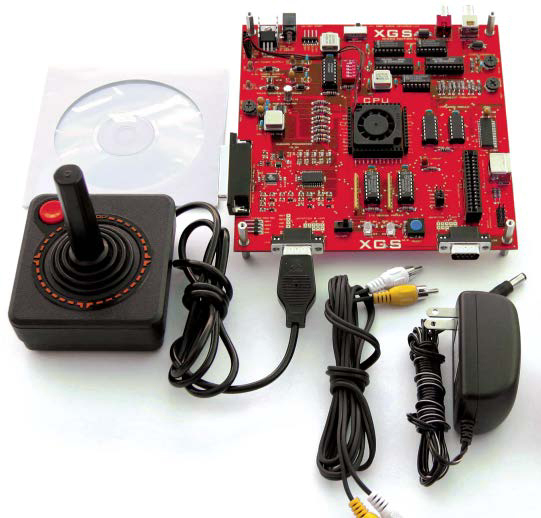Maker
LET THE
X GAMES
BEGIN
If you’ve ever wanted to try making a video game, here’s your chance.
By Alex Handy
For an engineer, designing consumer electronics is a nerve-wracking endeavor. Years of preparation and research are required to create and manufacture new equipment, and nowhere is this more evident than in the video game market. Zero hour for the EE ninjas of the video game world is looming on the horizon, as Microsoft, Sony, and Nintendo prepare to launch next-generation gaming hardware for the 2005 Christmas season.
Independent video game hardware designers are a dying breed, however. The three big game companies have something of a monopoly on the talent in this limited pool, as evidenced by the relatively small market proliferation of fresh video game hardware. This is primarily due to the fact that almost all video game-oriented educational institutions focus exclusively on the software and art side of the industry.
André LaMothe wants to change all that. At 37, LaMothe is fond of griping about the kids today: they can’t read binary, they never finish what they start, and they constantly bitch about the quality of games that they could never hope to create themselves.
“What these guys do today,” he grumbles, “most of them shouldn’t even be calling themselves programmers. They write scripts. The APIs do everything for them so they never need to learn the hardware.”
With around 15 books under his belt and hundreds of games published, thanks to his know-how, LaMothe’s earned the right to complain. He often receives email from aspiring designers who’ve read his books and want to make the next Halo. LaMothe replies to every one of these inquiries with the same command: “I tell them to make Pong. If you can make and finish Pong, you can make a real game.”
Trouble is, most of them can’t.
LaMothe has something of a reputation within the games industry as the Yoda of game design. He doesn’t work at Electronic Arts or publish million-dollar titles, but he does encourage and teach the next generation of prodigies, and those that prove themselves will be rewarded. Do or do not — there is no try.
Yoda carries a staff; LaMothe wields the XGame-Station (XGS), a $200 video game console kit (xgamestation.com). With all those billions of dollars and trillions of yen wrapped up in new console launches, it would seem that anyone else trying to sell gaming hardware would be doomed to failure — especially if your console has only 128KB of RAM and an 80 million instructions-per-second processor. But then, there’s a lot about the XGS that doesn’t quite fit with traditional console design wisdom.
The XGS is not made for playing games so much as it is for making games. The simple demos included with the console, such as Pac-Man, Tetris, and a basic racing game, are offered up not for entertainment, but for hacking. Indeed, the XGS manual, written by LaMothe’s apprentice Alex Varanese, has a section that explains how to easily modify these demos and games. Varanese also wrote a number of XGS programs, including the newly created tile-based graphics engine that allows developers to create platform games in the vein of the old Nintendo Entertainment System. With a light touch, XGS users can change the blocks in Tetris into smiley faces, or modify the background of the Pole Position clone to look like a cityscape. Both of these simple hacks are explained in the XGS manual — LaMothe and Varanese know that the easiest way to get into programming is to modify pre-existing code.

Photography by André LaMothe

The XGameStation features a readable circuit board and basic games for hacking purposes.
“The XGS is not made for playing games so much as it is for making games.”
“When I had Alex write the manual, I gave him the old docs for the Apple computers that Steve Wozniak wrote. I handed those to him and said, ‘Write it like this,’ “ says LaMothe.
LaMothe longs for those distant days, when electrical engineering and programming were significantly closer disciplines — the lone programmer creating his or her own vision with perfect clarity and dedication. The XGS software scene is homegrown and almost exclusively staffed by one-man dev teams. New hacks, games, and demos appear every day on www.nurve.net, and all of them are labors of love. Each one is a solution to the problems designers encounter while using the XGS. Each new game created is a triumph over the hardware’s limitations.
And this is exactly what LaMothe wants. The XGS was specifically designed with these limitations in mind: what it can’t do is more important than what it can. As such, developers must rediscover the tricks of the trade used by their predecessors.
Take interlacing, for example. Many moons ago, if a game designer wanted to draw more than two moving objects on screen at once, interlacing was the only way to get it done.
Every time the screen displays a moving image, it’s really putting up many single motionless images, each one swapped out quickly for the next, like a flipbook. The human eye can’t really distinguish between each of these still frames. Using interlacing requires drawing Pong paddle one and Pong paddle two in one frame, then drawing the ball and score on the next frame. These two divergent frames are then swapped back and forth, creating the illusion of simultaneous existence. This is why some old games, especially on the Atari and NES consoles, seem to flicker when a lot of action is going on.
Obviously, this sort of workaround isn’t used much anymore, but implementing interlacing in a video game is still a terrific way to learn how to interact directly with the video generator on a piece of hardware. This is a trick you’ll have to learn while programming the XGS.
To the uninitiated, the XGS looks just like any other circuit board. But to the trained eye, there are distinct features that stand out upon first glance. For starters, you can read it. Most modern circuit boards are a snarled mess of mysterious inputs, illegible 2-point font, and unlabeled pin outs. But the XGameStation’s various bits are labeled well enough that even a newbie can differentiate between the video processor and the sound filters.
Pop open your Xbox and try to find where the board processes sound — you’ll need a magnifying glass and an engineering schematic. As a hackable platform, Microsoft’s game console is impenetrable to all but the savviest hackers, but the XGS begs to be rewired, diddled with, and modified.
The XGameStation requires the sort of programming that just about anybody can learn with a little time and effort. Your humble author, for example, has only a rudimentary knowledge of both BASIC and 8086 assembly language — yet within a few minutes, ten years of brain rot vanished as vague memories of if-then loops began to return to the frontal lobes.
LaMothe and Varanese have created compilers for many different programming languages, and even the humble BASIC is usable here. No matter what you remember from your heady and youthful days at computer camp, you’ll likely find a way to apply it to design on the XGS.
While there’s absolutely no chance of the XGS replacing your Xbox, it could quickly take a beloved position on your workbench, next to the unfinished birdhouse and the old Apple II you’ve kept since your childhood. If you really want to get into game design, there’s no better way to gain a foundation of knowledge for the endeavor than by diving headlong into the XGameStation.
Alex Handy is a purple-haired newlywed who can’t put bricks to sleep by looking at them. He lives at www.gism.net.

